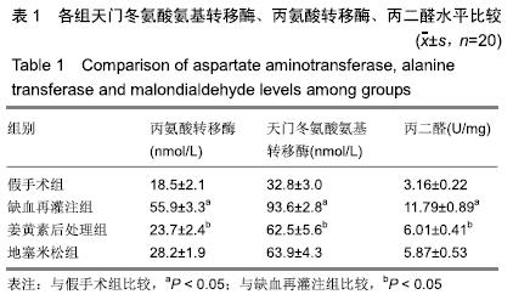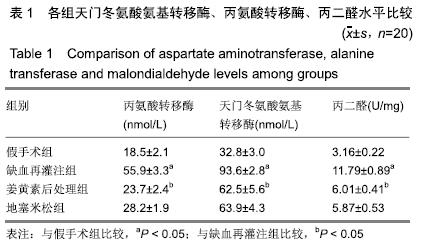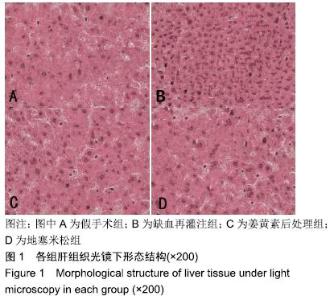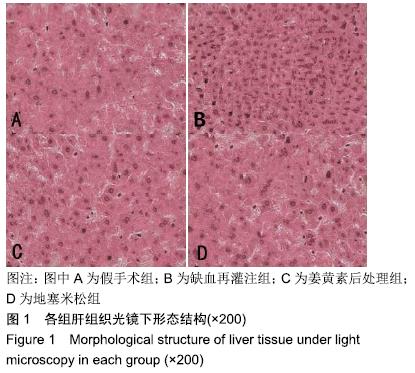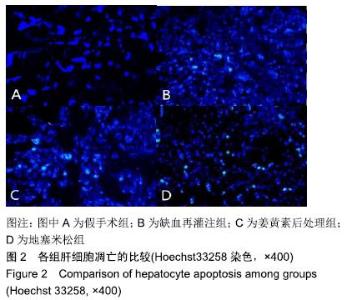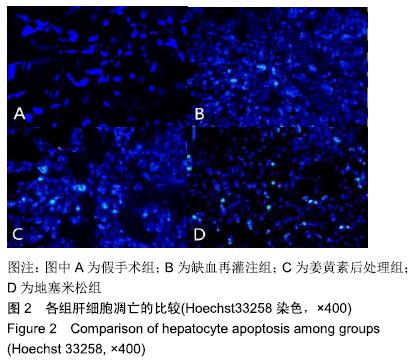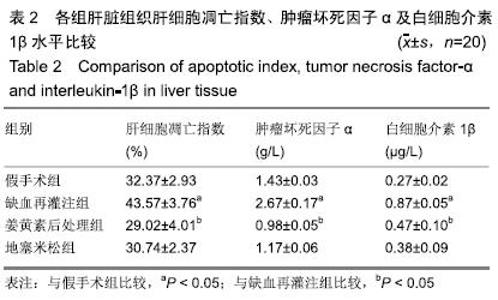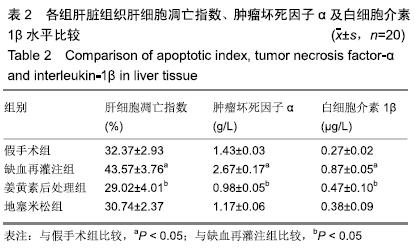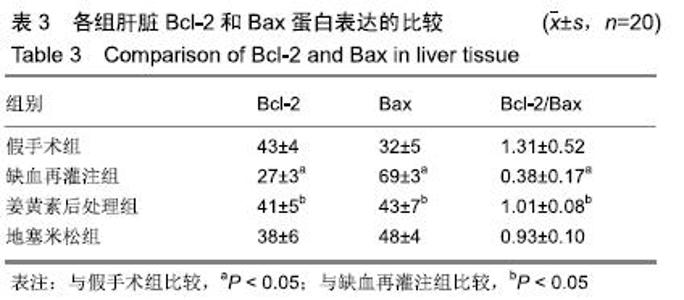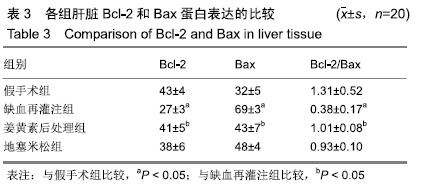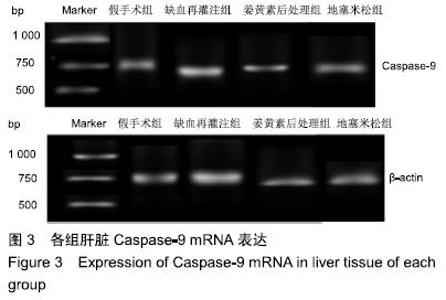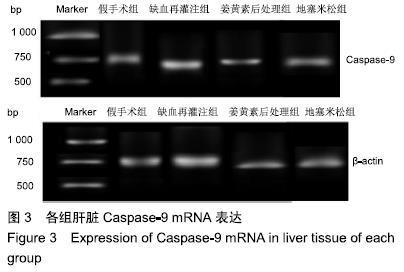[1] 安伟,刘军,管冬诗,等.姜黄素对大鼠肝脏冷缺血再灌注损伤的保护作用及其机制[J].中国普通外科杂志,2010,12(1):32-36.
[2] 金若天,殷涛.葛根素对大鼠肝脏缺血再灌注损伤后细胞凋亡的影响及作用机制[J].中国老年学杂志,2017,37(6):1344-1346.
[3] 陈刚,李学成,吴国庆.携带IL-13基因肝干细胞对冷缺血大鼠移植肝脏保护作用的研究[J].中国普外基础与临床杂志, 2017,17(2): 135-141.
[4] 陆宏伟,余强,李崇辉.长时间冷缺血对供肝胆管细胞原纤毛结构及功能的影响[J].中华普外科手术学杂志(电子版),2012,6(4): 372-379.
[5] 巫强,朱志军,徐倩.含饱和氢气灌注液对大鼠肝脏冷缺血再灌注肺损伤的影响[J].天津医科大学学报,2014,20(4):267-270.
[6] 陈晚平,杨尽晖,李珂,等.姜黄素对肝缺血再灌注损伤保护作用的研究[J].中国普通外科杂志,2010,19(1):37-40.
[7] 胡建平,钱建民,王学浩,等.大鼠原位肝脏低温灌注和复流模型的建立及意义[J].中华实验外科杂志,2001,18(4):366-367.
[8] KE B, KUPIEC-WEGLINSKI JW. Lipid Metabolites: The Alarm Signal to Trigger Liver Ischemia-reperfusion Injury. Transplantation. 2018;102(6):887-889.
[9] GENOVÉS P, GARCÍA D, CEJALVO D, et al. Pentoxifylline in liver ischemia and reperfusion. J Invest Surg. 2014;27(2): 114-124.
[10] 韩迪.葛根素注射液对大鼠缺血再灌注损伤肝脏的保护作用及其机制[J].中医临床研究,2016,8(19):17-19.
[11] WHITEHEAD RA, LAM NL, SUN MS, et al. Chronic Sciatic Neuropathy in Rat Reduces Voluntary Wheel-Running Activity With Concurrent Chronic Mechanical Allodynia. Anesth Analg. 2017;124(1):346-355.
[12] 窦磊,刘洪亮,陈孝平.小鼠原位肝移植模型及移植肝24h冷缺血再灌注模型的建立[J].中华移植杂志(电子版),2014,8(1):18-21.
[13] 咸国哲,吴晓本,刘景磊,等.姜黄素对大鼠移植肝缺血再灌注损伤指标血红素氧合酶-1表达的影响[J].中华实验外科杂志,2015, 32(1):193.
[14] CHEN M, DU ZY, ZHENG X, et al.Use of curcumin in diagnosis, prevention, and treatment of Alzheimer's disease.Neural Regen Res. 2018;13(4):742-752.
[15] 李亚楠,倪娟,方禹舜.姜黄素对脂多糖诱导炎症致软骨细胞凋亡及增殖能力的影响[J].中国组织工程研究,2018,22(32):5157-5162.
[16] 彭娜,王彦峰,何维阳,等.肝移植供肝缺血再灌注损伤的研究进展[J].中华肝胆外科杂志,2016,22(5):349-351.
[17] LIU HY, FU X, LI YF, et al.miR-15b-5p targeting amyloid precursor protein is involved in the anti-amyloid eflect of curcumin in swAPP695-HEK293 cells.Neural Regen Res. 2019;14(9):1603-1609.
[18] KEYVANLOO SHAHRESTANAKI M, BAGHERI M, GHANADIAN M, et al. Centaurea cyanus extracted 13-O-acetylsolstitialin A decrease Bax/Bcl-2 ratio and expression of cyclin D1/Cdk-4 to induce apoptosis and cell cycle arrest in MCF-7 and MDA-MB-231 breast cancer cell lines. J Cell Biochem. 2019;120(10):18309-18319.
[19] 陈龙,田焕娜,高玉峰.生黄合剂对缺血再灌注模型大鼠心肌细胞凋亡及相关基因bax、bcl-2 mRNA的影响[J].中国组织工程研究, 2016,20(27):4049-4054.
[20] JIA JJ, LI JH, YU H, et al. Machine perfusion for liver transplantation: A concise review of clinical trials. Hepatobiliary Pancreat Dis Int. 2018;17(5):387-391.
[21] 惠毅,闫曙光,王晓龙.乌梅丸对溃疡性结肠炎大鼠结肠上皮细胞凋亡和Bcl-2/Bax蛋白表达的影响[J].中华中医药学刊,2016, 34(1):149-151.
[22] CHIES AB, NAKAZATO PCG, SPADELLA MA, et al. Rivastigmine prevents injury induced by ischemia and reperfusion in rat liver. Acta Cir Bras. 2018;33(9):775-784.
[23] 祁翔,吕毅,刘昌.大黄素对肝细胞模拟冷缺血再灌注损伤的保护作用及机制[J].第四军医大学学报,2008,29(15):1417-1419.
[24] JONES RT, TOLEDO-PEREYRA LH, QUESNELLE KM. Selectins in Liver Ischemia and Reperfusion Injury. J Invest Surg. 2015;28(5):292-300.
[25] 王菲,喻文立,贾莉莉.异丙酚通过抑制JAK/STAT通路减轻肝冷缺血再灌注大鼠肾损伤[J].中国病理生理杂志,2016,32(11): 2026-2030.
[26] 薛佩彤,张全胜,李欣.依达拉奉对不同冷缺血时间大鼠移植供肝JAK2/STAT3信号通路的影响[J].天津医药,2017,45(6): 588-592.
[27] 向进见,田夫,李文岗,等.姜黄素对大鼠肝缺血再灌注早期肝组织一氧化氮表达的影响[J].世界华人消化杂志,2010,10(3): 987-992.
[28] AL-SAEEDI M, NICKKHOLGH A, SCHULTZE D, et al. Glycine Protects the Liver from Reperfusion Injury following Pneumoperitoneum. Eur Surg Res. 2018;59(1-2):91-99.
[29] 崇蕾,张维溪,聂颖.NOTCH2、NOTCH4受体在哮喘小鼠肺中的表达及布地奈德、姜黄素对其影响[J].医学研究杂志,2012, 41(4):73-75.
[30] 邹海波,孙晓峰.大鼠肢体缺血再灌注肾损伤时姜黄素后处理对Notch2/Hes-1通路的影响[J].中国现代医学杂志,2019(网络首发)
[31] 陈俊,林洁,赵忠胜.乌头汤对膝骨关节炎模型大鼠滑膜组织TLR4/NF-κB信号通路的影响[J].中国组织工程研究,2019, 23(29):4381-4386.
[32] 庾国桢,彭皓均,黄秀芳.黄连素对Aβ25-35诱导的HT22细胞TLR4/NF-κB信号通路的影响[J].中国实验方剂学杂志, 2018, 24(24):164-170.
|
